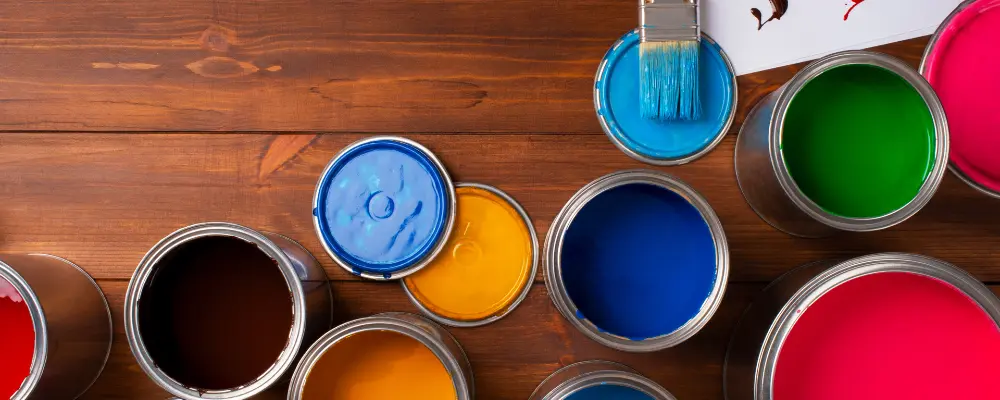Paint is very important for the aesthetic outlook of any building. In the market, many types of paint are available based on a different basis. Paints are broadly classified into two main categories: solvent-based vs water-based paint, distinguished by the type of base or solvent used in their formulation. The choice between solvent-based vs water-based paint can greatly impact the outcome of painting projects.
Understanding the differences between solvent-based and water-based paint is very important in selecting the right product for your specific requirements. Read today’s blog on Brick & Bolt to learn more about solvent-based and water-based paints.
Solvent-Based Paint
Solvent-based paint possesses both the pigment and the binder in an organic solvent carrier. The organic compounds give a hard and durable finish that withstands scratches on your wall.
Solvent-based paints contain organic solvents, typically derived from petroleum or other sources. These solvents act as carriers, allowing the paint to be applied smoothly. After you’ve painted the surface, the solvents essentially disappear into the air, leaving the hardened, adherent paint layer.
Water-Based Paint
Paint with pigment and binder mixed in water as the primary solvent is called water-based paint. It is also called latex or acrylic paint. Water-based paints do not need organic solvents to maintain the paint’s liquid condition or ease drying. Here, water works as the carrier and evaporates over the drying time, leaving the surface with a solid, sticky layer.
Water-based paints typically contain water, binders like acrylic or latex, colouring pigments, and additional ingredients such as thickeners, preservatives, and surfactants. These paints come in various formulations, including pure acrylic, vinyl acrylic, and acrylic latex. Each formulation offers different performance characteristics, such as ease of cleaning, flexibility, and durability.
Read More: Low-cost painting options to give a rich and classy look
Solvent-Based vs Water-Based Paint: Major Differences

1. Drying Time
The drying time of solvent-based paints is notably longer than that of water-based paints. Organic solvents typically have higher boiling points and evaporate more slowly than water. This slower evaporation rate leads to a longer drying time for solvent-based paints.
2. Durability and Longevity
Solvent-based paints are less durable and more apt to scratching and wear, while water-based paints are highly durable and resistant to abrasion and chemicals.
Solvent-based paints perform exceptionally well outdoors due to their ability to withstand UV radiation, extreme temperatures, and moisture. This makes them a popular choice for exterior surfaces like doors, trim, and metal structures. While water-based paints are only suitable to indoor use.
3. Environmental Impact
Solvent-based paints have potential safety risks of fire and explosion during production, transportation, storage, and use, especially in confined construction areas, which can lead to suffocation and explosions. Also, the organic solvents in these paints can harm human health.
Solvent-based paints have high levels of VOCs (Volatile Organic Compounds), with some conventional products containing over 400 units. This puts pressure on companies to address environmental protection and safety concerns when producing and using solvent-based paints.
Conversely, water-based paints are environmentally friendly and safe during production, transportation, storage, and use. They have significantly contributed to energy conservation, emission reduction, safety, and environmental protection.
4. Application Process
Solvent-based paints can be more difficult to work with than water-based paints. They often require more surface preparation, such as sanding, degreasing, and priming, to ensure proper adhesion. Additionally, the strong odor and fumes from the solvents require sufficient ventilation during application. While water-based paints are generally easier to apply and more user-friendly. They have a lower odour and can be applied directly to properly prepared surfaces without extensive priming or sanding. Clean-up is also much easier with soap and water.

5. Finish and Appearance
Solvent-based paints can provide a wide range of finishes, from high-gloss to flat or matte. These paints tend to have a smoother, more uniform appearance, with fewer brush marks or imperfections visible. The slow drying time of solvent-based paints allows the paint to level out and flow better, resulting in a more consistent finish. The pigments and resins in these paints are more resistant to fading or discolouration, allowing the colours to remain vibrant for longer periods.
While water-based paints have improved significantly in terms of finish and appearance, they may still have some limitations compared to their solvent-based paints. The faster drying time of water-based paints can make achieving a completely uniform finish more challenging, as brush marks or lap marks may be more visible, especially for inexperienced painters.
Read More: The Ultimate Guide to Choose the Interior Paint Colours For Your Home
Conclusion
The choice between water-based and solvent-based paints depends on several factors, such as project requirements, environmental concerns, and personal preferences. While solvent-based paints present superior durability and a wider range of finishes, water-based paints are more environmentally friendly, easier to apply, and suitable for most interior projects.
Water-based paints are the ideal option for your home indoors, while solvent-based paints are only suited for outdoors, where dirt and temperature change more often.

